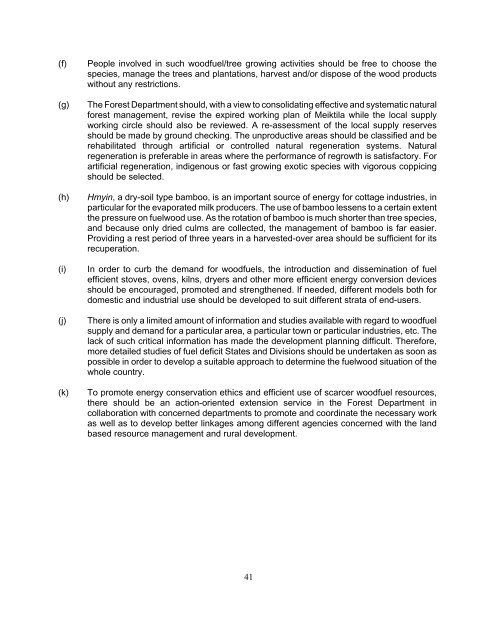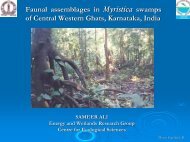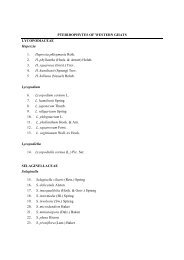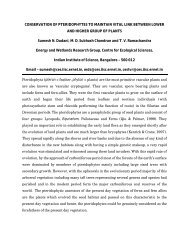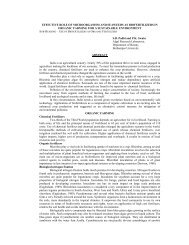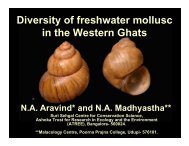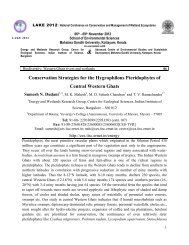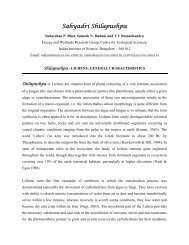regional wood energy development programme in asia ... - CES (IISc)
regional wood energy development programme in asia ... - CES (IISc)
regional wood energy development programme in asia ... - CES (IISc)
You also want an ePaper? Increase the reach of your titles
YUMPU automatically turns print PDFs into web optimized ePapers that Google loves.
(f) People <strong>in</strong>volved <strong>in</strong> such <strong>wood</strong>fuel/tree grow<strong>in</strong>g activities should be free to choose the<br />
species, manage the trees and plantations, harvest and/or dispose of the <strong>wood</strong> products<br />
without any restrictions.<br />
(g) The Forest Department should, with a view to consolidat<strong>in</strong>g effective and systematic natural<br />
forest management, revise the expired work<strong>in</strong>g plan of Meiktila while the local supply<br />
work<strong>in</strong>g circle should also be reviewed. A re-assessment of the local supply reserves<br />
should be made by ground check<strong>in</strong>g. The unproductive areas should be classified and be<br />
rehabilitated through artificial or controlled natural regeneration systems. Natural<br />
regeneration is preferable <strong>in</strong> areas where the performance of regrowth is satisfactory. For<br />
artificial regeneration, <strong>in</strong>digenous or fast grow<strong>in</strong>g exotic species with vigorous coppic<strong>in</strong>g<br />
should be selected.<br />
(h) Hmy<strong>in</strong>, a dry-soil type bamboo, is an important source of <strong>energy</strong> for cottage <strong>in</strong>dustries, <strong>in</strong><br />
particular for the evaporated milk producers. The use of bamboo lessens to a certa<strong>in</strong> extent<br />
the pressure on fuel<strong>wood</strong> use. As the rotation of bamboo is much shorter than tree species,<br />
and because only dried culms are collected, the management of bamboo is far easier.<br />
Provid<strong>in</strong>g a rest period of three years <strong>in</strong> a harvested-over area should be sufficient for its<br />
recuperation.<br />
(i) In order to curb the demand for <strong>wood</strong>fuels, the <strong>in</strong>troduction and dissem<strong>in</strong>ation of fuel<br />
efficient stoves, ovens, kilns, dryers and other more efficient <strong>energy</strong> conversion devices<br />
should be encouraged, promoted and strengthened. If needed, different models both for<br />
domestic and <strong>in</strong>dustrial use should be developed to suit different strata of end-users.<br />
(j) There is only a limited amount of <strong>in</strong>formation and studies available with regard to <strong>wood</strong>fuel<br />
supply and demand for a particular area, a particular town or particular <strong>in</strong>dustries, etc. The<br />
lack of such critical <strong>in</strong>formation has made the <strong>development</strong> plann<strong>in</strong>g difficult. Therefore,<br />
more detailed studies of fuel deficit States and Divisions should be undertaken as soon as<br />
possible <strong>in</strong> order to develop a suitable approach to determ<strong>in</strong>e the fuel<strong>wood</strong> situation of the<br />
whole country.<br />
(k) To promote <strong>energy</strong> conservation ethics and efficient use of scarcer <strong>wood</strong>fuel resources,<br />
there should be an action-oriented extension service <strong>in</strong> the Forest Department <strong>in</strong><br />
collaboration with concerned departments to promote and coord<strong>in</strong>ate the necessary work<br />
as well as to develop better l<strong>in</strong>kages among different agencies concerned with the land<br />
based resource management and rural <strong>development</strong>.<br />
41


